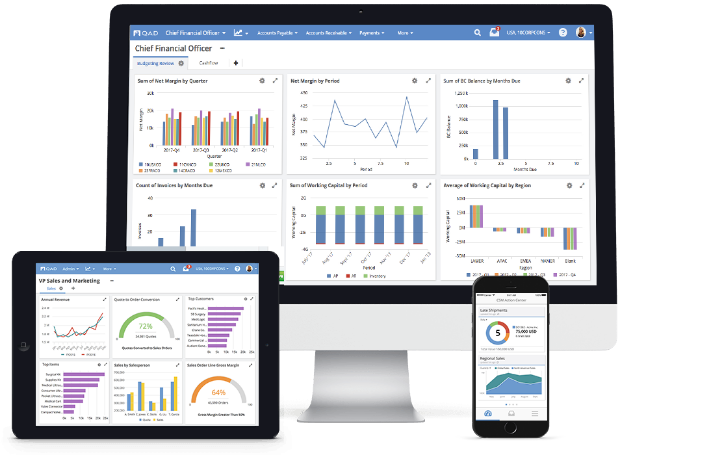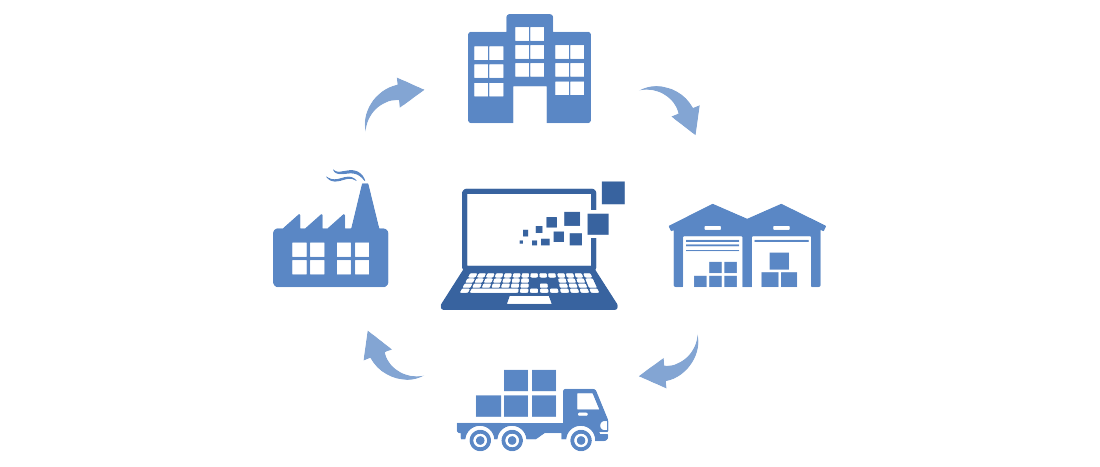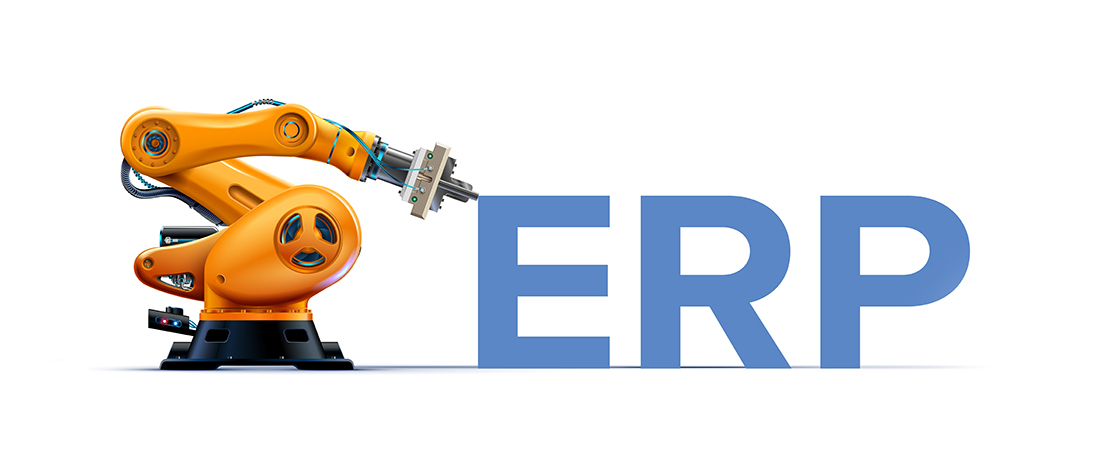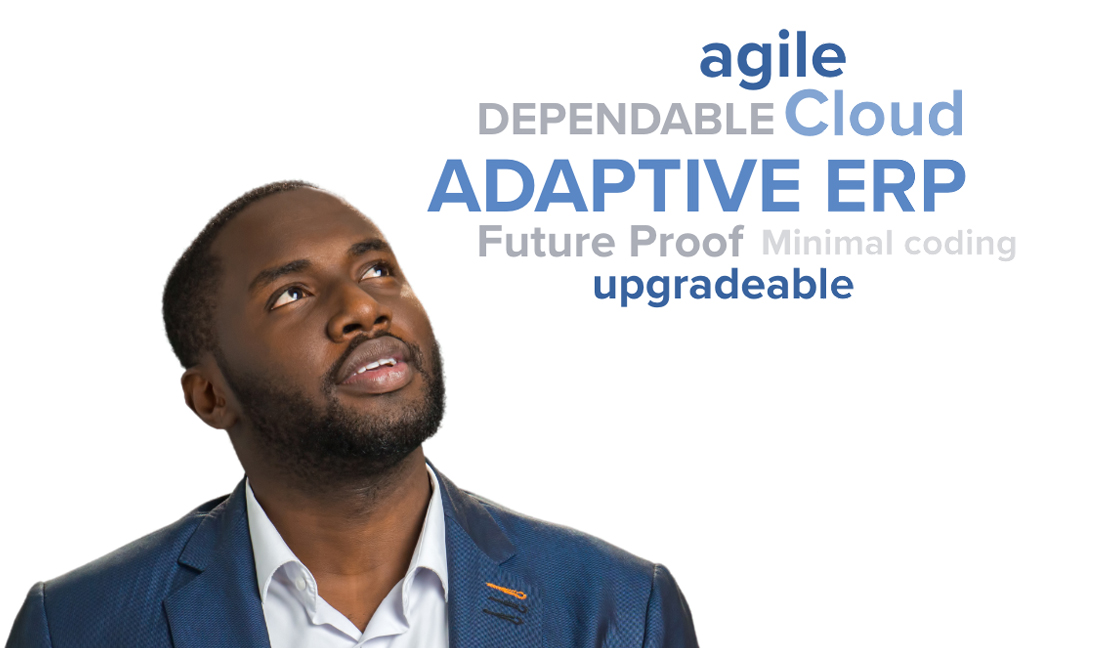A Comprehensive Guide to ERP (Enterprise Resource Planning)
Definition of ERP
ERP stands for "Enterprise Resource Planning" and refers to a type of software or system used by a business to plan and manage daily activities such as supply chain, manufacturing, services, financials and other processes. Enterprise Resource Planning software can be used to automate and simplify individual activities across a business or organization, such as accounting and procurement, project management, customer relationship management, risk management, compliance, and supply chain operations.
What is an ERP System?
Individual ERP applications can offer software as a service (SaaS), while a complete suite of ERP applications forms an ERP system that can be used to effectively communicate and bring together a variety of business processes. ERP systems enable a flow of data between individual applications, typically through common databases either on-site/on-premise or in the cloud. ERP is frequently referred to as the system of record for an organization, ensuring all data is centralized, contributing to a single source of truth across the business.
ERPs connect every aspect of an enterprise. An ERP software system allows for better performance and project management that helps plan, budget, predict and accurately report on an organization’s financial health and processes. ERP systems have become essential for businesses small, medium, and large across many industries.

How Does an ERP System Work?
The main purpose of an ERP system is to increase organizational efficiency of an organization by managing and improving how company resources are utilized. Improving and/or reducing the number of resources necessary without sacrificing quality and performance are keys to effectively improving business growth and profitability.

ERP systems typically cover all aspects of business operations and commonly provide:
- An integrated system
- Common database
- Real-time operation
- Support for all applications/components
- Common user interface across application/components
- On-premise, cloud hosted, or SaaS deployment
ERP software has the ability to collect and compare metrics across departments and provide a number of different reports based on roles or specific user preferences. The data collected makes finding and reporting on data faster and gives a complete view of business performance with complete insights on how resources are being spent.
ERP synchronizes reporting and automation by reducing the need to maintain separate databases and spreadsheets that would have to be manually merged to generate reports. This combined data collection and reporting offers valuable insight, such as where to cut costs and streamline processes, providing the information to make real-time business decisions.
Types of ERP Systems & ERP Software Deployment Options
Enterprise Resource Planning software is considered a type of “enterprise application”, which refers to software designed to satisfy the software needs of an organization and improve business performance. There are many different ERP systems available today that range greatly depending on the size, function, and needs of an organization. Types of ERP systems generally refer to deployment options and include cloud ERP, on-premise ERP and hybrid ERP (some systems in the cloud and some on-premise).
Each ERP solution system is often tailored to support different aspects of a business, meet an organization’s business requirements and have different methods of deployment.
What is Big Business ERP vs. Small Business ERP
In the past, “big business ERP” addressed large organizations that often deployed onsite/on-premise ERP solutions and had an abundance of resources to dedicate to IT and other support to analyze, customize, upgrade and deploy their software solutions.
The phrase “Small Business ERP” or “SME (small and medium-sized enterprise) ERP” commonly referred to ERP software systems with business management applications typically created to meet the specific needs for a small to mid-sized business.
Today, these phrases are used less frequently as the important factor is not company size but determining if the ERP system is effectively addressing current and future business requirements, no matter the size of the organization.It’s imperative that organizations consider and select ERP systems that eliminate the need for costly customizations, adapt to the rapid pace of business change, address future technologies and meet other identified requirements.
What are the Types of ERP Deployments?
There are three main types of ERP systems that function with different deployment model options. The most common types of ERP systems include cloud ERP, on-premise ERP, and hybrid ERP.
- On-Premise ERP software is implemented onsite and maintained in physical office space within an organization, hosted on the company’s own computers and servers for full control, support and ownership of the entire system once implemented.
- Cloud-based ERP software is a web-based solution, known as Software as a Service (SaaS), where an organization accesses and stores data on any device with an internet connection, usually through the purchase of a subscription. Continual support, updates, training, and flexible customizations supported by the software provider.
- “Hybrid” ERP software refers to a combined implementation of cloud-based and on-premise ERP system solutions. The combination of hosting and deployment services vary by provider. These models can provide ERP users the flexibility to migrate between delivery models, or integrate benefits not available existing implementation.
Different ERP vendors support different deployment model options. Combinations of options, often referred to as “hybrid” ERP deployment may offer a combination of hosting and deployment services. These hybrid models can provide users with a flexible ERP solution and integrate benefits that may not have been available within their existing implementation.
A History of ERP (Enterprise Resource Planning)
The term “ERP” was first used in the 1990s by the Gartner Group, but enterprise resource planning software and systems have been used in the manufacturing industry for over 100 years and continue to evolve as industry needs change and grow.
ERP History/Timeline:
- 1913: An engineer named Ford Whitman Harris developed the Economic Order Quantity (EOQ) model, a paper-based manufacturing system for production scheduling.
- 1964: Toolmaker Black and Decker adopted the first Material Requirements Planning (MRP) solution that combined EOQ with a mainframe computer.
- 1970s-1980s: Computer technologies evolved and concept software handled business activities outside of manufacturing, including finance, human resources data, and customer relationship management (CRM).
- 1983: MRP II was developed and featured “modules” and integrated core manufacturing components, and integrated manufacturing tasks into a common shared-data system.
- 1990s-2000s: Gartner Group coins term “ERP” to differentiate from MRP-only systems. ERP systems expanded to encompass business intelligence while handling other functions such as sales force automation (SFA), marketing automation and eCommerce.
- 2000-2005: Cloud-based ERP software solutions arrive when ERP software makers create “Internet Enabled” products, providing an alternative to traditional on-premise client-server models.
- Today: Software-as-a-Service (SaaS) and Anything-as-a-Service (XaaS) offer new delivery models for ERP. Remote web-based access for cloud ERP solutions provide mobile solutions, security, and integration with the changing industries and smart technologies. Modern ERP systems have begun including integrations with advanced intelligent technologies like Artificial Intelligence (AI), machine learning, robotic process automation (RPA), the Internet of Things (IoT), natural language processing (NLP), in-memory databases, and even social media to provide comprehensive solutions for every industry.
- Future: The global ERP software market is projected to grow at a CAGR of 10.2% from 2019 to 2026, reaching USD 78.40 billion by 2026.
Want to learn more about the Heroes of Manufacturing?
What Industries Can Benefit From ERP?
ERP software can be used in any industry to help a business become more efficient. It provides an effective communication tool that can manage information between internal and external departments, assist with daily activities to manage projects, track adherence to guidelines, and handle day-to-day intricacies that come with running a business.
Because the roots of enterprise planning software are closely associated with manufacturing, there are robust manufacturing ERP solutions that cater to a variety of specific industries. ERP software systems are very diverse and are key parts of many industries, including but not limited to:
- Manufacturing
- Industrial Machinery and Components
- Construction and Home Improvement
- Electronics and Technology
- Automotive
- Aerospace and Defense
- Healthcare, Pharmaceutical and Life Sciences
- Agribusiness, Farming and Agriculture
- Food and Beverage
- Healthcare and Hospitality
- Clothing, Consumer Goods and Retail
What are ERP Modules?
Over time, ERP systems have grown to include support for other applications and “ERP modules" that support day-to-day business functions. In many ERP systems, these common functional areas are grouped into ERP modules, including but not limited to:
- Financial Accounting
- Management Accounting
- Human Resources
- Manufacturing
- Order Processing
- Supply Chain Management
- Project Management
- Customer Relationship Management (CRM)
- Data Services
- Inventory Management
- Warehouse Management

Signs You Need an ERP System:
Identifying broken processes is important for growth and finding areas of improvement within your organization. Here are a few examples of signs you need an ERP system:
- Use/Rely heavily on separate databases/spreadsheets/programs that require manual processes for data management and fall out of sync regularly
- Information and analytics are difficult to access and/or out-of-date
- Day-to-day processes, such as paper-based accounting, financial reporting, etc., are difficult or overly time-consuming.
- Sales and customer experience are suffering due to inaccurate or incomplete data and cause poor reputation for reliability and services
- Inefficient/complex/complicated IT processes. Current systems have bad scalability and fragmented legacy systems solutions.
- IT time is spent fixing/patching legacy systems to try and keep up with growth
- Does not support new and advanced technologies like IoT, artificial intelligence, etc.

When Does Your Business Need ERP?
Business development often focuses on goals that coincide with a company’s short-term and long-term growth, as well as analyzing potential business challenges. Conducting a regular analysis of current systems and processes helps identify when a business may benefit from integrating an ERP system.
An ERP solution should be taken into consideration when existing business systems and processes are:
- No longer function or function inefficiently (throttling/bottlenecking)
-
No longer support the growth of the company
-
Lack current security requirements to mitigate risk
Identifying broken processes is important for growth and finding areas of improvement. Here are a few examples of opportunities that may signal a process is no longer supporting company growth:
- Use/Relying heavily on separate databases/spreadsheets/programs that require manual processes for data management and fall out of sync regularly
-
Information and analytics are difficult to access and/or out of date
-
Day-to-day processes are difficult or overly time consuming, such as paper-based accounting, financial reporting, etc.
-
Sales and customer experience are suffering due to inaccurate or incomplete data and cause poor reputation for reliability and services
-
Inefficient/complex/complicated IT processes. Current systems have bad scalability, fragmented systems legacy solutions.
-
IT time is spent fixing/patching legacy systems to try and keep up with growth
-
Does not support new and advanced technologies like IoT, artificial intelligence, etc.
Once broken processes are identified, businesses can take the next steps to overcome these business challenges and support business growth.
Does your manufacturing business have the characteristics of an Adaptive Enterprise in order to survive and thrive?
What is the Business Value of ERP?
ERP systems are used to help businesses of all sizes overcome challenges—from small businesses to massive enterprises. Early business practices may no longer keep up with growing demand and require more efficient business tools, like ERP, to effectively manage a business’ systems and resources.
ERP software systems provide many benefits to the health and growth of a business.
What are the Benefits of ERP?
- Cost savings and improved ROI efficiency. Increased productivity and efficiency as a result from the integration and automation that ERP software provides
- Improve business insight. Improve decision making with a single aggregated source of truth and real-time data
- Manage Regulatory Compliance. Manage and monitor compliance with regulatory standards, and even set up alerts for non-compliance
- Mitigate and reduce risk. Automate core business operations, manual tasks, and reporting. Reduce human errors, and free up employee time and resources
- Enhance collaboration. Break down communication barriers for efficient collaboration and coordination to improve job efficiency.
- Improve supply chain and distribution network reliability. Use demand-driven MRP to forecast supply and demand and prepare for fluxes in orders and supply chain
- Scalability. Consistent infrastructure for streamlined operations can grow as your business grows
- Optimize customer and partner management. service, customer relationship management, as well as partner and supplier management with insight from seamless shared information
How Do I Select an ERP System?
Picking and deploying an ERP system can be a daunting task with many software solutions to choose from. When selecting an ERP system, it is important that the software meets the needs and goals of your company while having the support required to implement an ERP system.
Here is a quick checklist to review when first comparing between ERP Systems to help narrow down your options.

Checklist for Selecting an ERP System
Does the ERP software/vendor that is being considered:
- Meet your system requirements?
- Meet/align with company goals?
- Integrate/compatible with current existing systems?
- Have partner Network/Availability for local support?
- Offer training/support options?
- Have references and recommendations from customers?
- Continuously improve and develop to utilize new technology and adapt to challenges?
Once the ERP options have been narrowed down to solutions that are most compatible with your current systems and goals, it can be helpful to review the benefits and features of the systems with key decision makers of the organization. Having the insight and support of these decision makers can boost adoption and support of an ERP implementation throughout the organization.
What is ERP Implementation?
The process of transitioning to a new ERP system varies by project and requires planning and strategizing to best fit the needs of your company. Choosing the right ERP implementation strategy is key to finding success with your new system. Implementation is an important part of any ERP project. The time and financial investment involved depends on several factors, including deployment model, system complexity, implementation strategy, company sizes and the resources dedicated to the project. Done poorly, an implementation project can eat up valuable resources. Done well, an ERP integration can set your company up for an exciting new level of success. Learn more about the steps of a successful ERP implementation below.
What are the ERP Implementation Steps?
At each step in QAD’s scalable ERP system integration process, teams should review all milestones, deliverables, and commitments and report on progress. Our strategy, called Effective On-Boarding (EOB), makes the ERP system implementation fast and easy. This EOB strategy includes the following steps.
-
Plan
During the planning phase, we engage stakeholder groups and form the project team, which will draft a plan with milestones, deliverables, as well as vendor, customer and partner resources. Governance structures such as the Steering Committee and relevant processes around change control, risk, and issue management are agreed upon and set up during this stage as well.
-
Design
Next, we hold business process workshops using built-in process maps designed around major manufacturing industry best practices. During this time, we review how closely the customer enterprise follows these industry standard processes and fill any necessary gaps, which may involve alternative process configurations or designing extensions.
We also gather customer-specific requirements for subsidiary services, such as interfacing, EDI, eInvoicing, etc. and complete the technical work to include those subsidiary services.
At the end of these workshops, we have an agreed-upon functional scope at the process-step and work-instruction level. We then configure our software with those process steps and amend the detailed work instructions accordingly to meet a customer’s specific requirements. Domain and data workshops also occur to identify data structures, cleansing and migration issues. Static data is also loaded into the system.
-
Test
QAD conducts two conference room pilots (CRPs) as well as user acceptance testing (UAT). At each testing step, errors are addressed and should become fewer with each test. The first set of CRPs usually take three to four weeks, with less time needed each round.
-
Deploy
Once UAT is complete, the team plans for the data cut-over and go-live. We draft a detailed plan for when to stop the old system and start the new to minimize any disruption. During go-live, we institute a period of highly focused customer care and support. After this hyper-care period is over and the system is fully handed over to the customer, we conduct an extensive post-project review to ultimately ensure the benefits to the customer have been realized.
What are ERP Implementation Strategies?
There are multiple strategies for a successful ERP system implementation, each with advantages and disadvantages. Here are a few of the most common strategies to consider.
-
Single-Step Method
When using the single-step method, all users move to the new system at once. ERP benefits occur more quickly, but there is a greater risk of errors that can be harder to smooth out later in the process.
With the single-step ERP implementation strategy, you can quickly reap its benefits, such as increased productivity, improved insights, and lower operating costs. This ERP implementation strategy is ideal for users who have strict time constraints and need to complete configuration, testing and training by the projected go-live date.
-
Phased Rollout
In a phased rollout, the deployment of features, tools, and components is carried out over a period of weeks to months. This more measured approach allows for glitches to be caught and addressed more smoothly, but it does take more time to see ERP benefits, and there may be additional costs to maintain two systems at the same time.
Phased rollouts are a safe and effective ERP implementation method. Phased rollouts give organizations more time to learn core functions first and expand from there. This ERP implementation option helps give organizations peace of mind as they iron out any kinks and migrate away from their previous systems.
-
Parallel Rollout
A parallel rollout involves using a legacy system in parallel with the new system for an extended time. Parallel rollouts are typically the least risky way to implement an ERP system because it enables users to revert to a legacy system in the event of any roadblocks. This implementation method ensures that users always have access to vital functions regardless of any problems that occur.
While there is less risk involved given the legacy system is still in operation as a backup, it can be an expensive and time-consuming approach to run two systems.
-
Hybrid Approach
This approach draws from all of the above. A company may choose to do a single-step rollout of one system module but perform a more phased or parallel approach with other more complex or high-stake modules. This ERP implementation approach enables organizations to save time and money on transitioning certain functions while safeguarding vital modules that may require additional troubleshooting.
-
Engage
In this step, we meet with the customer to understand requirements, define the scope of work, set expectations, and identify timing, costs and resources. We then commit to a signed statement of work which acts as the foundation of the project.
Thank you for reaching out to QAD! Your inquiry has been forwarded to the appropriate representative who will contact you shortly.
In the meantime, for more information on how we can work together toward building an Adaptive Enterprise please subscribe to the QAD Blog for commentary on the latest news and announcements from QAD and the industry.
If you would like to change your message settings, visit our Subscription Preference Center.
